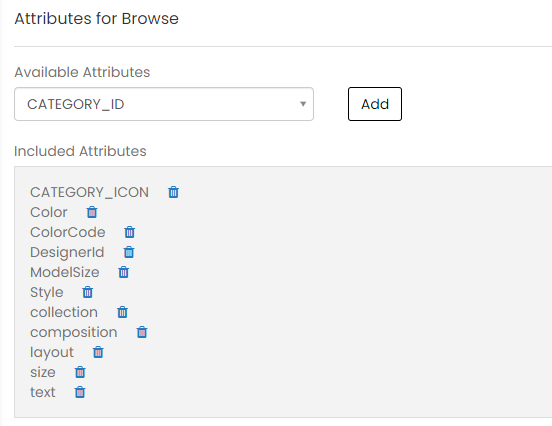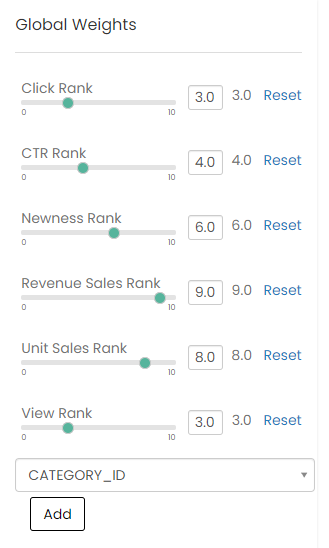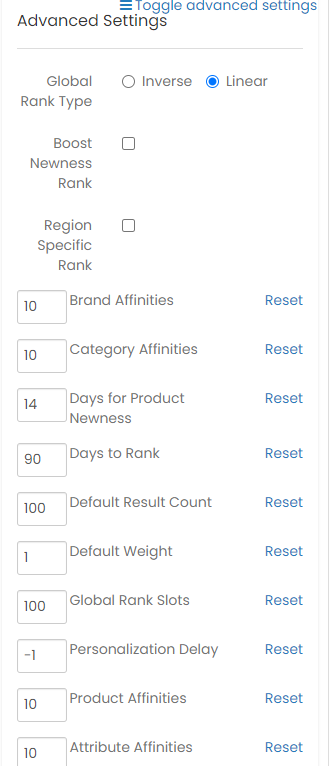Configuration
The Browse Configuration lets the user specify weights to be used for a specific category or group of categories as well as for a specific region. This feature is enabled via Site Configurations. Please contact the Algonomy team to enable this.
Configuring the weights on the various pieces Discover considers enables retailers to get the best results for their customers.
Discover configuration settings apply site wide. Work with your Algonomy team to choose the best settings for your site, generally, you'll find these values through systematic testing of different options.
The current Discover configuration page is available from the Omnichannel Personalization Portal by choosing Search|Browse > Browse Configuration.

Note: Changes to the weights take effect the day after you save them.
SiteWide
The default Discover configurations are sitewide. They apply to all the products in the catalog and all the users in the same way.
Context
This enables you to override Discover configurations for a group of categories and/or regions and have different weights compared to site wide settings.
MVT Treatments
The MVT Treatments page enables users to set up and review MVT Treatments for Discover Attributes.
Attribute Configuration
To keep the sorting system as lean and fast as possible, we don't include every product attribute in the product models. Product attributes that will be acted on to execute rules for filtering can be added to the model through the Attributes for Browse section. To add a new attribute to the model, click "Add and enter the attribute name. All attributes included in the model will appear on the attribute configuration page.

Personalization Weights
These attributes control how an individual customer's history influences the sort order.
You can increase or decrease the weight values of each of the attributes listed below for clicks, views, or purchases. Each event type has its own weight, so if you wanted to emphasize previously viewed products while completely avoiding previously purchased products, you could set the product ID value to 2 for views and 0 for purchases.
Valid weights range from 0 (the attribute is not used) to 10. The higher the weight value, the more influence it has on improving the product's final ranking in the sort order. The personalization algorithm incorporates customers' past activity as well as activity from their current sessions.

Brand
How much weight should be given to products of the same brand as previously viewed products?
-
Brand Viewed
-
Brand Purchased
Categories
How much weight should be given to products in the same sub-categories as previously viewed and purchased products?
-
Viewed Categories
-
Purchased Categories
Price Quartiles
How much weight should be given to a product's price? To determine price affinity, the customer's view and purchase history is reviewed to find preferred price range in a category.
-
Price Quartile Viewed
-
Price Quartile
Product Newness Affinity
Represents a customer's affinity for viewing or purchasing new products.
Newness is either based on when the product entered the feed or the release date, if that exists. Newness is not based on absolute time, but is relative to other products.
-
Product Newness Affinity Viewed
-
Product Newness Affinity Purchased
Products
How much weight should be given to previously viewed and purchased products?
-
Viewed Products
-
Purchased Products
Attributes
Configured attributes can be used for personalization as well.
For example, if attribute personalization is enabled for attribute color, and the customer has viewed or purchased products with color blue, then discover results will be personalized with the attribute color:blue products showing up higher in the result.
Blending Weights

Diversity
Controls how much variety of brand and category are incorporated into the results.
The control penalizes products that overlap with previous products in the list (that is, they have the same brand or sub-category as the previous product). The penalty grows as you see more and more items having the same value. The end result is to prevent showing too many similar items in the sorted results. The diversity control can be set from 0 (emphasize relevance only) to 100 (emphasize diversity). The default value is 25.
Personalization
Controls how many personalized products are incorporated into the results. The personalization control determines what percentage of the merged results come from personalized results list.
The personalization control can be set from 0 (no personalized results) to 100 (an equal number of personalized results are merged with the global ranked results). The default value is 50.
For category pages, you control the ratio of personalized products by preferring the personalized or global sort strategy over the other (or by preferring only one of the two strategies). See Search/Browse Setup for more on the category sort strategies.
Global Weights
These weights affect the algorithm that sorts products when the customer's history is not known.
The higher the weight value, the more influence it has on improving the product's final ranking in the sort order.
Weight values range from 0.0 (the attribute is not used) to 10.0.

Click Rank
How important are the total number of clicks the product has received?
CTR Rank
How important is a product's click-through rate (for all customers on the site)?
Newness Rank
How much priority should the newest products get?
Revenue Sales Rank
How much priority should the products with the highest revenues get?
Unit Sales Rank
How important is a product's overall sales rank?
View Rank
How important are the total number of views the product has received?
Attribute Rank
This feature enables the client to specify a custom feed attribute to act as a rank for the products in the catalog. The attribute needs to have an integer value for all the products and the weight determines how this rank plays against other ranks to generate the global ranking of the products.
Advanced Settings
These settings enable finer control over various aspects of the Discover algorithm. In almost all cases, the default values are good for a variety of use cases. Please contact the Algonomy team if there is any need to update these settings.

Global Rank Type
Determines the algorithm to be used to generate the global ranks for catalog items. There are two possible values - Linear or Inverse. Inverse rank is more stable than Linear. In all our previous tests, inverse rank has outperformed the linear one.
Boost Newness Rank
Whether or not to boost new products in discover results.
Product, Brand, Category and Attribute Affinity limits
Controls the discover personalization behavior. Discover administrator can control how many products, brands, categories, and attributes will be used as customer affinities to perform personalization. Default values are 10 for all of them.
Days For Product Newness
Products released within N number of days are considered new.
Days to Rank
Number of days to lookback to generate the metrics likes views, clicks, CTR, Revenue. These metrics (or components ranks) are then used to generate the global rank based on their weights.
Note: By default these values include: 7, 14, 20, 30, 60, 90.
Default Result count
Default number of items to be returned within Discover results when no count parameter is specified in the API request.
Default Weight
Default value for personalization weights. These setting is currently marked for deprecation.
Global Rank Slots
This is a very advanced setting and should almost never be changed. It specifies number of slots to be used to distribute the component ranks and then take average and median to arrive at final global rank for a product.
Personalization Delay
Events within the last N number of seconds are skipped when calculating personalization affinities. This setting enables us to avoid jitter among the response products as the user builds up their history.
Product Affinities
The Product Affinities limits the number of products considered within personalization boosts to the first N number of products returned from the User Profile Service. By default, the User Profile Service returns the last 50 products the user has interacted with. There is no sorting of products when choosing from the 50 products returned.
Attribute Affinities
The Attribute Affinities limits the number of attribute values considered within personalization boosts. An attribute value is considered when there is a personalization weight for that attribute and one or more products returned by the User Profile Service include a value for that attribute. There is no sorting of attribute values when choosing from among the possible attribute values.
View/Purchase newness affinity threshold
Newness boost is only applied when customer has viewed or purchased more than threshold percentage of new items.
View/Purchase attribute affinity threshold
Attribute personalization is applied only when customer has viewed or purchased more than threshold percentage of items with desired item attribute.